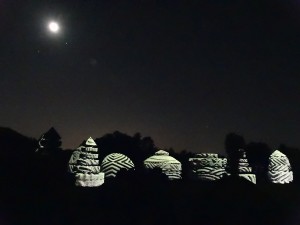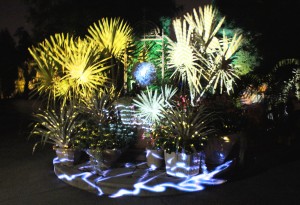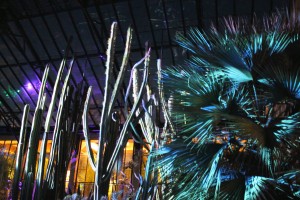Garden Meets Digital at Nightscape
September 1st, 2015
One of the best things about gardening is that it’s such a basic antidote to our complicated, fast-paced digital world.
That’s a reason I wasn’t sure I was going to like Nightscape – Longwood Gardens’ 2015 exhibit that brings high-tech, cutting-edge projection lighting and New-Age music to my all-time favorite horticultural haven.
But rather than turn haven to havoc, Nightscape is artfully done and paced gently enough to impress this old-fogey plant geek.
I liked it… especially how the Topiary Garden’s sculpted evergreens turned into pulsating musical instruments.
It’s hard to describe exactly what Nightscape is.
The closest example is that room with wave-like, moving lighted walls and ceilings that was the main entrance to the 2012 Hawaiian-themed Philadelphia Flower Show.
There’s similarity because the Philadelphia visual art studio that did that – Klip Collective – also did Nightscape.
This installation, though, is much more elaborate and projects moving light on plants at nine different sites throughout Longwood Gardens. It’s called Nightscape because it goes into action only after dark.
I could try describing what these nine creations look like, but you’re much better off just watching a video on Klip Collective’s website.
While you’re at it, check out the Pennlive piece I wrote on how Longwood Gardens’ flagship Main Fountain Garden is now gone and in the midst of a total revamp that’s going to take 2 years and $90 million to complete.
Longwood Director Paul Redman thought this concept could be impressive on Longwood’s plant canvas after he saw a small installation Klip had done at Bartram’s Garden in 2012.
That was the same year that Bruce Munro’s nighttime light show was wow-ing Longwood visitors.
So Redman contacted Klip co-founder Ricardo Rivera to see if something unique could be done for this season, when Longwood’s Main Fountain Garden was going to be out of action for a $90 million revamping.
I have no idea how you go about projecting images on conifer needles and palm fronds, but apparently Klip’s artists spent a year experimenting in Longwood’s gardens to perfect it.
Rivera describes Klip’s work as “immersive projection” and says his studio’s aim is to create art that you experience rather than look at.
That hit home to him in an early Klip installation in which fireflies were projected in a 100-foot-wide veil of smoke in a meadow.
Rivera says the idea was to create an interesting view, but rather than just watch it, people instead went into it.
In other words, they were drawn to the light and wanted to become part of the experience.
You’ll see that at Nightscape in the long, evergreen-lined walk called the Flower Garden Drive.
In daytime, it’s a nice stroll about the length of a football field with hedge-backed pink begonias, silver plectranthus and purple-blooming Verbena bonariensis on either side.
But when the huge projector comes on for Nightscape, the area pulsates in blue and pink light with tunnel-like white lights running down the tall hedges. It made me feel like I was walking through a time tunnel or at least in some kind of futuristic Disney World attraction.
Nightscape’s projected lighting makes all of the plants seem like they’re alive – in an animated sort of way, that is.
For instance, the projection on the Legacy Tree (the biggest Chinese scholar tree you’ll likely ever see) makes it look like light is running up the tree’s xylem channels.
The flashing lights on palm fronds in the conservatory’s Silver Garden look like electricity is shocking the bladed foliage.
And coolest of all is the Topiary Garden, where about a dozen topiary evergreens first are turned into objects with moving parts, then into a band of cartoonish instruments of blaring horns and hopping drums, moving in sync to the original music.
You’ll have until the end of October to see Nightscape in action.
Note that it only runs Wednesdays through Saturdays and that you’ll need special Nightscape tickets to get in. A limited number of those tickets are sold each day to keep the crowds manageable.
Nightscape tickets are $27 for ages 19 and up, and $17 for ages 5-18. If you’re a Longwood member, Nightscape admission is free, but you still need to get a specific Nightscape ticket.
Your Nightscape ticket also gets you into Longwood for the whole day, so you don’t have to wait until dusk to show up. Everybody without a Nightscape ticket gets kicked out at 6 p.m., but with your handy-dandy Nightscape wrist band, you’ll be able to see the Gardens from 9 a.m. on.
The optimal time to see Nightscape in September is 8:30 p.m. until the Gardens close at 11 p.m. In October, it’s dark to get the full effect beginning at 7:30 p.m.
The projectors begin running about a half-hour before those optimal viewing times.
Allow at least 90 minutes to get to all nine Nightscape spots.
Take your camera, but I’ll warn you… it’s very difficult to get good shots after dark and with lots of people jockeying around.
Longwood offers some tips for photographing Nightscape on its blogsite.










